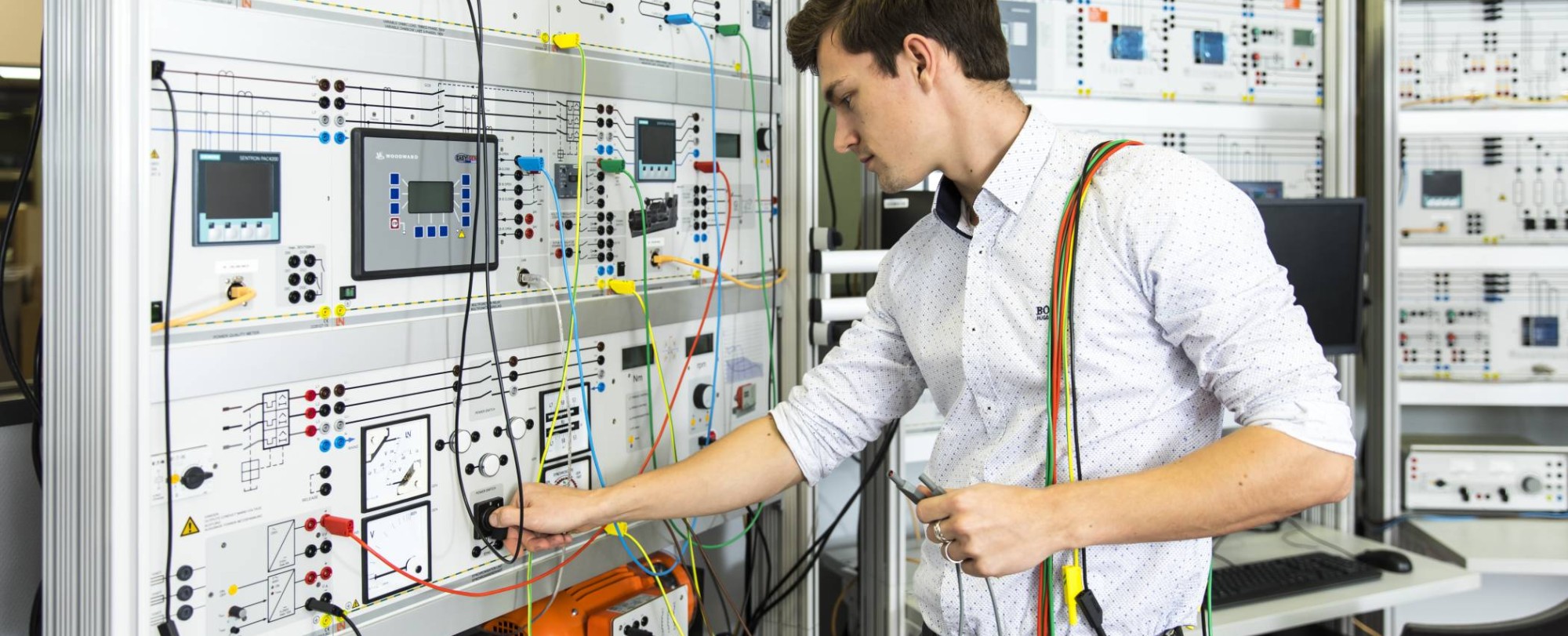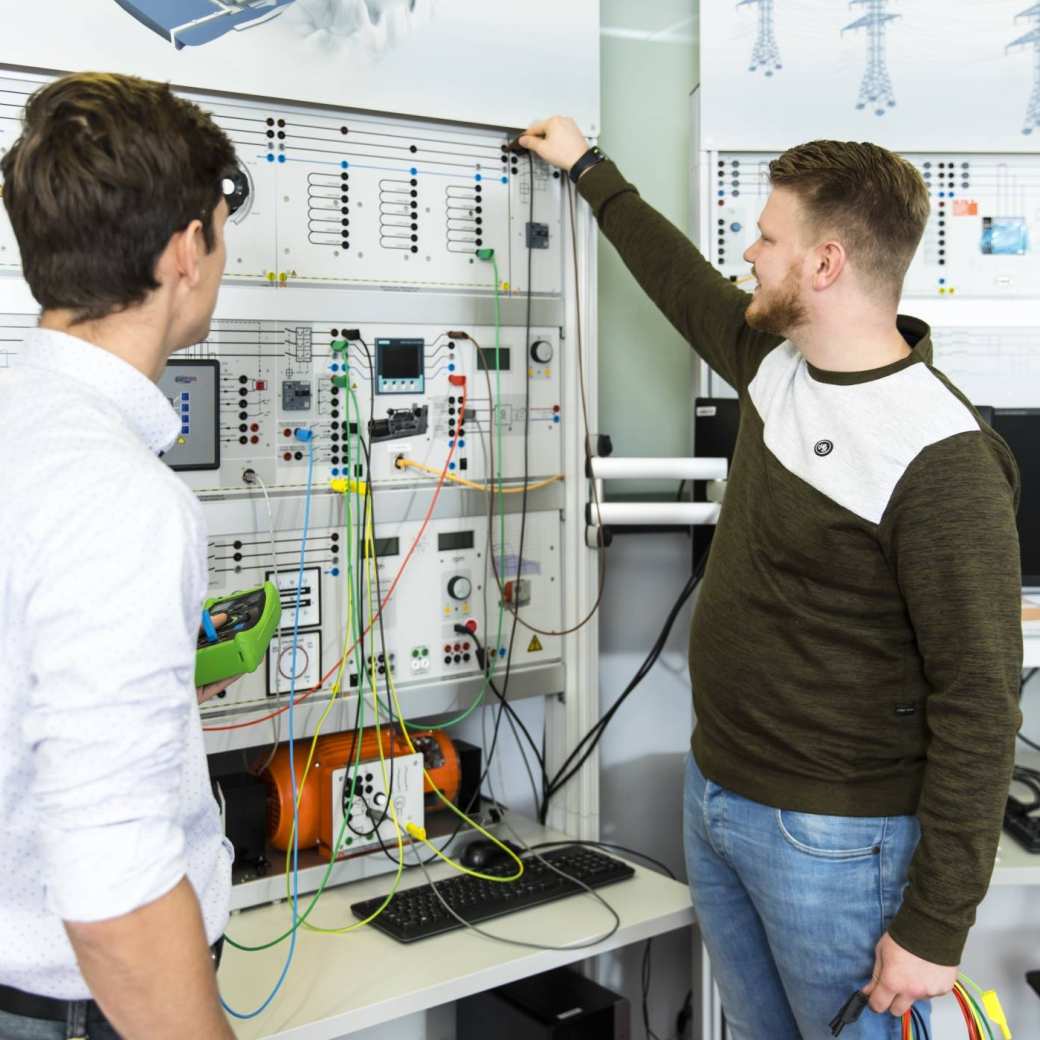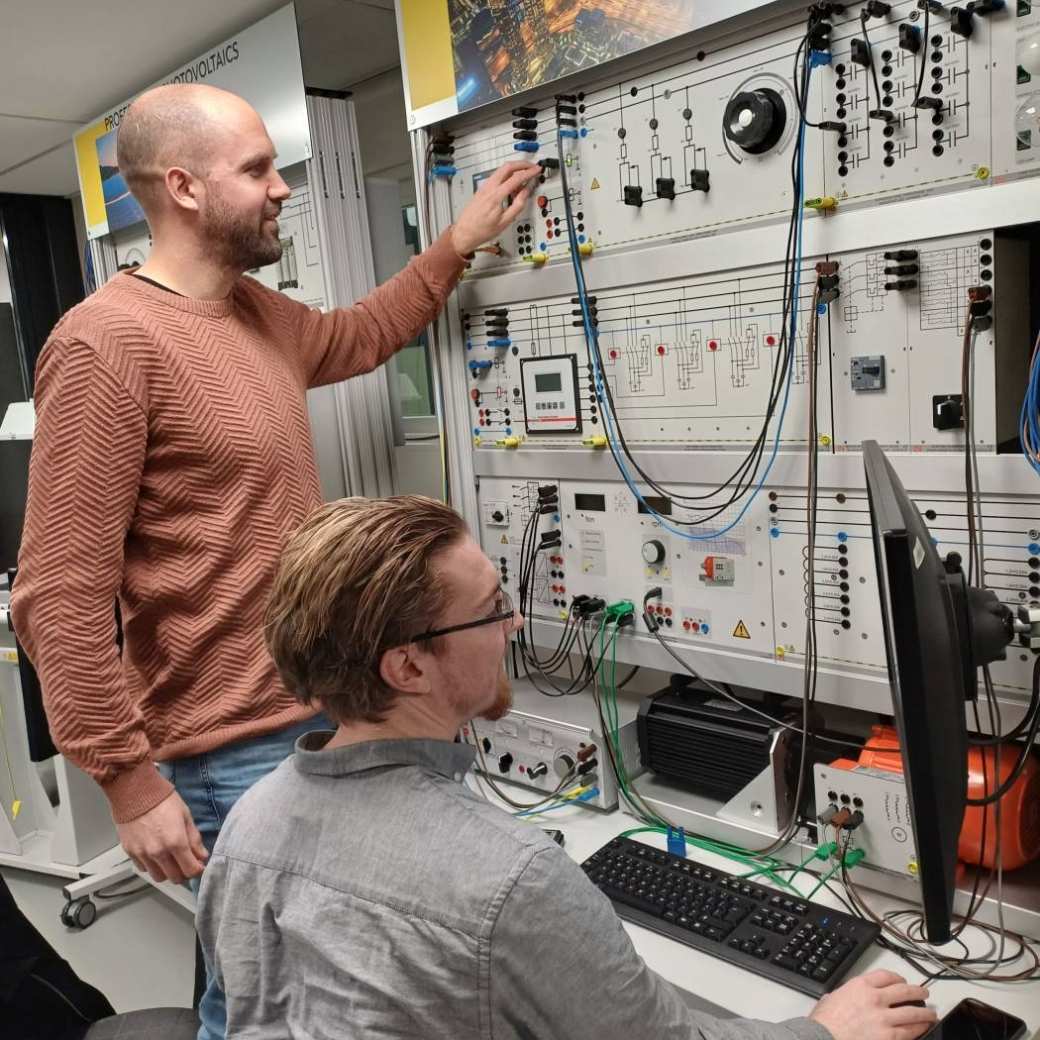Cursus WATTS

Startdatum in overleg
De HAN WATTS simulator is een installatie waarbij je de totale integratie van opwekking, transport en distributie van elektrische energie ‘hands on’ kunt oefenen en trainen. Via deelcertificaten leer je het totale net begrijpen.
In het kort
Werken met de simulator
De HAN W@TTS simulator van Lucas Nulle is een installatie waarbij een totale integratie van opwekking, transport en distributie van elektrische energie ‘hands on’ kan worden geoefend en getest. Dat kan zowel voor onderwijsdoeleinden als voor onderzoeksdoeleinden. De installatie kan in de volle breedte worden ingezet; van een simulatie van een smart grid van een woonwijk tot aan een Europees elektriciteitsnet.
Via deelcertificaten van de HAN W@TTS cursussen, leer je het totale net te begrijpen. De cursus is Engelstalig. Het behalen van een deelcertificaat duurt twee dagdelen (meestal een middag en aansluitende avond). Het totaal aantal onderdelen is hieronder weergegeven.

HAN W@TTS onderdelen
- Course Wind Power Plants With DFIG (Double Fed Induction Generator)
This course describes the design and function of modern wind power plants. The control of variable-speed wind turbines is studied using a doubly-fed asynchronous generator as an example. Wind can be emulated realistically with a servo-machine test stand and "WindSim" software.
- Course Investigation of Transformers
This course focuses on measurements around three-phase transformers bij operating with no load and with a short circuited secondary, R, RL and RC loads, Parallel operation of transformers, Current distribution for different vector groups and Determining zero impedance.
- Course Energy Management
The aim of this course is to explore the response of linear, time-invariant complex loads in AC and 3-phase power systems especially in terms of theory and to demonstrate the relationships between electrical current and voltage. Measurements are conducted to investigate the consumers of R, RL and RC balanced and unbalanced load situations in a three-phase power system both in star and delta configuration (including an asynchronous motor) and these measurements are then tested by means of calculation.
- Course Generator Protection
In this course you will acquire practical knowledge of all of the relevant topics involving generator protection. Experimental investigations of industrial protection equipment and circuitry used in conjunction with a synchronous generator form the focal point of this work and demonstrate how this equipment functions, operates and responds in operation.
- Course High Voltage Direct Current (HVDC)
The following subjects are part of the course: Manual and automatic synchronization, control of HVDC reactive power with modification to the flow power, Individual control of reactive power for both converter stations, Observation of losses for various lengths of HVDC lines, Provision of a power network with passive consumers by means of HVDC (black start), Coupling of wind turbines and investigation of fault ride-through (FRT) behavior in HVDC systems.
- Course Power Stations
This course is intended to impart a practical knowledge of the topic of grid or mains synchronization and automatic generator control. Experiments focus on the functionality, operating response and effects of synchronous generators. Above that the training also looks at Power plants and typical characteristics and parameters, Commissioning and putting into operation different types of power stations and Automatic load-following operation of an externally measured active and reactive load.
- Course Power Transmission
This course imparts a comprehensive and practical knowledge of high-voltage power transmission lines. A 3-phase line model is used to measure the characteristic parameters of a power transmission line, besides evaluating its operational characteristics in quantitative as well as qualitative terms. These characteristic parameters include R, L and C, star and delta voltages, voltage differences, line, load and charging currents, short-circuit current in the event of a short circuit, active and reactive power (capacitive and inductive), power dissipation and inherent reactive power.
- Course Photovoltaic Systems In Grid-Coupled Operation
This training system permits a realistic simulation of the sun's path. Thus, it is also possible to perform the experiments in the laboratory without real sunlight using the emulators. The design of photovoltaic systems connected to the grid is realistically conveyed. In order to stabilize the power grid, techniques such as de-rating the inverter power and a variable local network power transformer are employed.
- Course Protective Systems For HV-Transmission Lines
- Overcurrent Time Protection
Theoretical and practical treatments of overcurrent time protection with the help of related software provide a first insight into protection technology. The resources necessary to protect lines, for instance, as well as associated fault types are introduced and explained. Determination of reset ratios makes it possible to analyse the operating principles and accuracy of digital protective relays. Setting options and overcurrent time protection characteristics are demonstrated in a subsequent test of trip response.
- Directional Overcurrent Time Protection
This section deals with directional overcurrent protection by studying its theoretical principles in practical experiments. Determination of inherent system times provides an insight into the chronological sequences involved in protection technology. Subsequently, advanced applications of overcurrent protection are revealed by recording a dependent overcurrent characteristic and testing recognition of energy-flow direction.
- Overvoltage and Undervoltage Protection
A theoretical introduction and subsequent practical experiments demonstrate the use and functionality of under and over voltage protection. Working with the protective relays and other components in the experimental setup provides a good insight into this type of protection technology.
- Directional Power Protection
Theoretical and practical treatments of directional protection with the help of related software provide a further insight into protection technology. The capabilities of power protection are demonstrated, and the operating principle of this sort of protective relay elucidated in practical experiments.
- Earth Fault Protection
This course section deals with earth fault protection. After a theoretical introduction, various measurements are conducted to elucidate a grid's response to earth faults. In subsequent experiments, a line model is protected against such faults by means of a relay, and the functionality of earth fault protection devices is explained.
- Protection of Parallel Lines
This course section deals with the protection of parallel lines. After an introduction to theoretical fundamentals, a variety of experiments are conducted to elucidate the advantages and disadvantages of parallel energy supply. The design and parametrization of a system of protective devices for this type of power grid are explained.
- Overcurrent Time Protection
- Course Pumped-Storage Power Stations
This course has the following content: Historical development of pumped-storage power stations, Present and future significance of pumped-storage power stations, Manual and automatic power regulation with synchronous machines, Automatic reactive power compensation with synchronous machines, Use of modern information technology such as networked sensors/actuators, PLC control and SCADA user interface, "Smart metering" of a balancing node for quasi-autonomous operation of a sub-network and Improved coordination between energy demand and generation.
- Course Smart Grids
This course imparts a general practical knowledge of smart grids. New technologies will permit power grids to be better prepared for future requirements. More flexible network management is to make rising proportions of renewable energy supply compatible with conventional power plant infrastructure. The numbers and diversity of such decentralised power plants requires a new type of management in the operation of power grids - an intelligent network or "smart grid".
Training content- Improved coordination between power demand and generation
- Use of modern information technology such as internet, sensors, controllers and wireless transmission equipment
- Smart metering - digital electricity meters measure power consumption at power grid's end points
- Shifting the household consumption away from the peak load
- Running of flexible applications such as air conditioning directly by power supply companies outside peak load periods
- Course Micro Grids
A power grid with power sources, power lowering loads (drains) and potential storage units which can alternate between ‘island operation’/island parallel to grid’ and grid parallel operation is called a microgrid. This modern form of an electricity grid system permits operation on conventional utility grids as well as self-sufficient operation with local power supply. Alternating between both operating modes is for the most part possible without interruption.
Training content- Fundamentals of island grids (microgrids)
- Automatic voltage control of a generator in an island grid
- Automatic reactive power (VAr) control of several generators in parallel operation
- Coordination of energy requirement and generation in a stand-alone, island grid
- Use of modern IT technology, for example, networked sensors and actuators, PLC control and SCADA operating interface.
- ‘Smart Metering’ of a balanced node in order to make a subnetwork or microgrid autonomous
- Course Automatic Generator Regulation and Grid Synchronisation
This course is designed to convey practical know-how in the fields of synchronisation to the electricity grid and automatic generator regulation. The focus of these experiment-based investigations is on synchronous generators and involves learning about their operation, operating response and functioning. Parts of the course are also Manual and Automatic synchronisation and Putting a multi-function relay into operation.
- Course Investigating Busbars
This course has the following content; Understanding the basic design of switchgear, Understanding the difference between an isolator and a circuit breaker, Learning about the functions of double busbars, Analysing power distribution in switchgear, Practising correct switching sequences, Switching outgoing feeders safely for humans and equipment, Changing busbars safely for humans and equipment and Learning to think before acting (incorrect switching can prove very costly.
Verdere Informatie
Kom naar de Open Avond Deeltijd
Kom sfeer proeven tijdens onze Open Avond Deeltijd. Stel je vragen en kom alles te weten over het post-hbo aanbod op het gebied van Engineering en Automotive.

Direct contact
Vragen over de opleiding? ASK HAN! We helpen je graag persoonlijk verder.
Nieuwsgierig?
Dankzij de HAN geeft je jouw carrière een positieve impuls en kun je verder groeien binnen jouw vakgebied. Bekijk het uitgebreide aanbod op het gebied van Engineering/Automotive, variërend van een enkele studiedag of meerdaagse (post hbo-)cursussen.
